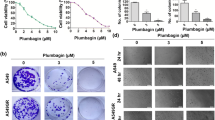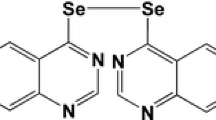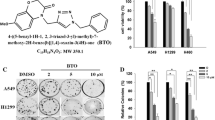Abstract
A number of effective anti-cancer drugs contain either indole or quinoline group. Compounds fused indole and quinoline moieties altogether as indolylquinoline were rarely reported as anti-cancer agents. We reported here that a synthetic indolylquinoline derivative, 3-((7-ethyl-1H-indol-3-yl)-methyl)-2-methylquinoline (EMMQ), inhibited the growth of human non-small cell lung cancer (NSCLC) cells in dose- and time-dependent manners. The cytotoxicity was mediated through apoptotic cell death that began with mitochondrial membrane potential interruption and DNA damage. EMMQ caused transient elevation of p53 that assists in cytochrome c release, cleavage of downstream PARP and procaspase-3 and mitochondria-related apoptosis. The degree of apoptotic cell death depends on the status of tumor suppressor p53 of the target cells. H1299 cells with stable ectopic expression of p53 induced cytotoxicity by disrupting mitochondria functions that differed with those transfected with mutant p53. Knocking-down of p53 attenuated drug effects. EMMQ suppressed the growth of A549 tumor cells in xenograft tumors by exhibiting apoptosis characteristics. Given its small molecular weight acting as an effective p53 regulator in NSCLC cells, EMMQ could be an addition to the current list of lung cancer treatment.








Similar content being viewed by others
References
Mariette C, Piessen G, Triboulet JP (2007) Therapeutic strategies in oesophageal carcinoma: role of surgery and other modalities. Lancet Oncol 8:545–553
Chang A (2011) Chemotherapy, chemoresistance and the changing treatment landscape for NSCLC. Lung Cancer 71:3–10
Hida T, Ariyoshi Y, Kuwabara M, Sugiura T, Takahashi T, Takahashi T, Hosoda K et al (1993) Glutathione S-transferase pi levels in a panel of lung cancer cell lines and its relation to chemo-radiosensitivity. Jpn J Clin Oncol 23:14–19
Tiseo M, Boni L, Ardizzoni A (2005) Platinum-based versus non-platinum-based chemotherapy in advanced non-small-cell lung cancer: does cisplatin versus carboplatin make a difference? J Clin Oncol 23:6276–6277
Giovanella BC, Stehlin JS, Wall ME, Wani MC, Nicholas AW, Liu LF, Silber R et al (1989) DNA topoisomerase I–targeted chemotherapy of human colon cancer in xenografts. Science 246:1046–1048
Kanzawa F, Sugimoto Y, Minato K, Kasahara K, Bungo M, Nakagawa K, Fujiwara Y et al (1990) Establishment of a camptothecin analogue (CPT-11)-resistant cell line of human non-small cell lung cancer: characterization and mechanism of resistance. Cancer Res 50:5919–5924
Saleem A, Edwards TK, Rasheed Z, Rubin EH (2000) Mechanisms of resistance to camptothecins. Ann NY Acad Sci 922:46–55
Afzal O, Kumar S, Haider MR, Ali MR, Kumar R, Jaggi M, Bawa S (2015) A review on anticancer potential of bioactive heterocycle quinoline. Eur J Med Chem 97:871–910
Ding Y, Nguyen TA (2013) PQ1, a quinoline derivative, induces apoptosis in T47D breast cancer cells through activation of caspase-8 and caspase-9. Apoptosis 18:1071–1082
Sedic M, Poznic M, Gehrig P, Scott M, Schlapbach R, Hranjec M, Karminski-Zamola G et al (2008) Differential antiproliferative mechanisms of novel derivative of benzimidazo[1,2-alpha]quinoline in colon cancer cells depending on their p53 status. Mol Cancer Ther 7:2121–2132
Souli E, Machluf M, Morgenstern A, Sabo E, Yannai S (2008) Indole-3-carbinol (I3C) exhibits inhibitory and preventive effects on prostate tumors in mice. Food Chem Toxicol 46:863–870
Nakamura Y, Yogosawa S, Izutani Y, Watanabe H, Otsuji E, Sakai T (2009) A combination of indol-3-carbinol and genistein synergistically induces apoptosis in human colon cancer HT-29 cells by inhibiting Akt phosphorylation and progression of autophagy. Mol Cancer 8:100
Chakrabarti G, Basu A, Manna PP, Mahato SB, Mandal NB, Bandyopadhyay S (1999) Indolylquinoline derivatives are cytotoxic to Leishmania donovani promastigotes and amastigotes in vitro and are effective in treating murine visceral leishmaniasis. J Antimicrob Chemother 43:359–366
Pal C, Raha M, Basu A, Roy KC, Gupta A, Ghosh M, Sahu NP et al (2002) Combination therapy with indolylquinoline derivative and sodium antimony gluconate cures established visceral leishmaniasis in hamsters. Antimicrob Agents Chemother 46:259–261
Ramesh C, Kavala V, Raju BR, Kuo C-W, Yao C-F (2009) Novel synthesis of indolylquinoline derivatives via the C-alkylation of Baylis–Hillman adducts. Tetrahedron Lett 50:4037–4041
Wang JP, Lin KH, Liu CY, Yu YC, Wu PT, Chiu CC, Su CL et al (2013) Teroxirone inhibited growth of human non-small cell lung cancer cells by activating p53. Toxicol Appl Pharmacol 273:110–120
Weng JR, Bai LY, Chiu CF, Wang YC, Tsai MH (2012) The dietary phytochemical 3,3′-diindolylmethane induces G2/M arrest and apoptosis in oral squamous cell carcinoma by modulating Akt-NF-κB, MAPK, and p53 signaling. Chem Biol Interact 195:224–230
Agarwal C, Singh RP, Agarwal R (2002) Grape seed extract induces apoptotic death of human prostate carcinoma DU145 cells via caspases activation accompanied by dissipation of mitochondrial membrane potential and cytochrome c release. Carcinogenesis 23:1869–1876
Chipuk JE, Green DR (2008) How do BCL-2 proteins induce mitochondrial outer membrane permeabilization? Trends Cell Biol 18:157–164
Elmore S (2007) Apoptosis: a review of programmed cell death. Toxicol Pathol 35:495–516
Lakin ND, Jackson SP (1999) Regulation of p53 in response to DNA damage. Oncogene 18:7644–7655
Petty TJ, Emamzadah S, Costantino L, Petkova I, Stavridi ES, Saven JG, Vauthey E et al (2011) An induced fit mechanism regulates p53 DNA binding kinetics to confer sequence specificity. EMBO J 30:2167–2176
Burris HA 3rd (2009) Shortcomings of current therapies for non-small-cell lung cancer: unmet medical needs. Oncogene 28(Suppl 1):S4–S13
Aqil M, Elseth KM, Vesper BJ, Deliu Z, Aydogan B, Xue J, Radosevich JA (2014) Part I-mechanism of adaptation: high nitric oxide adapted A549 cells show enhanced DNA damage response and activation of antiapoptotic pathways. Tumour Biol 35:2403–2415
Roos WP, Kaina B (2006) DNA damage-induced cell death by apoptosis. Trends Mol Med 12:440–450
Green DR (2005) Apoptotic pathways: ten minutes to dead. Cell 121:671–674
Haupt S, Berger M, Goldberg Z, Haupt Y (2003) Apoptosis: the p53 network. J Cell Sci 116:4077–4085
Marchetti P, Castedo M, Susin SA, Zamzami N, Hirsch T, Macho A, Haeffner A et al (1996) Mitochondrial permeability transition is a central coordinating event of apoptosis. J Exp Med 184:1155–1160
Toledo F, Wahl GM (2006) Regulating the p53 pathway: in vitro hypotheses, in vivo veritas. Nat Rev Cancer 6:909–923
Wang Y, Ji P, Liu J, Broaddus RR, Xue F, Zhang W (2009) Centrosome-associated regulators of the G(2)/M checkpoint as targets for cancer therapy. Mol Cancer 8:8
Chang C, Zhu YQ, Mei JJ, Liu SQ, Luo J (2010) Involvement of mitochondrial pathway in NCTD-induced cytotoxicity in human hepG2 cells. J Exp Clin Cancer Res 29:145
Bose P, Thakur S, Thalappilly S, Ahn BY, Satpathy S, Feng X, Suzuki K et al (2013) ING1 induces apoptosis through direct effects at the mitochondria. Cell Death Dis 4:e788
Ji H, Ding Z, Hawke D, Xing D, Jiang BH, Mills GB, Lu Z (2012) AKT-dependent phosphorylation of Niban regulates nucleophosmin- and MDM2-mediated p53 stability and cell apoptosis. EMBO Rep 13:554–560
Qian J, Zou Y, Rahman JS, Lu B, Massion PP (2009) Synergy between phosphatidylinositol 3-kinase/Akt pathway and Bcl-xL in the control of apoptosis in adenocarcinoma cells of the lung. Mol Cancer Ther 8:101–109
Malki A, Ashry el S (2014) In vitro and in vivo efficacy of a novel quinuclidinone derivative against breast cancer. Anticancer Res 34:1367–1376
Pronier E, Levine RL (2015) IDH1/2 mutations and BCL-2 dependence: an unexpected Chink in AML’s armour. Cancer Cell 27:323–325
Acknowledgments
This work is supported by Grants from National Taiwan Normal University (99D, 103T3040B2 and 104T3040C2). Technical assistance of College of Life Science and Instrumentation Center, National Taiwan University with the confocal laser microscopy is appreciated.
Author Contribution
Chun-Yen Liu and Pei-Tsen Wu designed and performed experiments, discussed and interpreted the data. Jing-Ping Wang, Po-Wei Fan, Chang-Hung Hsieh and JG performed experiments. Ching-Fa Yao provided and purified the tested material. Chun-Li Su and Chien-Chih Chiu gave suggestion on study design, discussed and interpreted the data. Kang Fang designed, supervised study, discussed, interpreted the data and wrote the manuscript. All authors read and approved the final manuscript.
Author information
Authors and Affiliations
Corresponding author
Ethics declarations
Conflict of interest
The authors declare that they have no competing interest.
Statement on the welfare of animals
All applicable international, national, and/or institutional guidelines for the care and use of animals were followed. All procedures performed in studies involving animals were in accordance with the ethical standards of the institution or practice at which the studies were conducted.
Additional information
Chun-Yen Liu and Pei-Tsen Wu have contributed equally.
Rights and permissions
About this article
Cite this article
Liu, CY., Wu, PT., Wang, JP. et al. An indolylquinoline derivative promotes apoptosis in human lung cancer cells by impairing mitochondrial functions. Apoptosis 20, 1471–1482 (2015). https://doi.org/10.1007/s10495-015-1165-6
Published:
Issue Date:
DOI: https://doi.org/10.1007/s10495-015-1165-6




